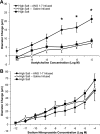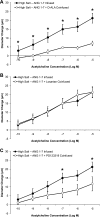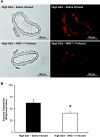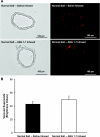Angiotensin-(1-7) and low-dose angiotensin II infusion reverse salt-induced endothelial dysfunction via different mechanisms in rat middle cerebral arteries
- PMID: 20656887
- PMCID: PMC2957344
- DOI: 10.1152/ajpheart.00328.2010
Angiotensin-(1-7) and low-dose angiotensin II infusion reverse salt-induced endothelial dysfunction via different mechanisms in rat middle cerebral arteries
Abstract
The goals of this study were to 1) determine the acute effect of ANG-(1-7) on vascular tone in isolated middle cerebral arteries (MCAs) from Sprague-Dawley rats fed a normal salt (NS; 0.4% NaCl) diet, 2) evaluate the ability of chronic intravenous infusion of ANG-(1-7) (4 ng·kg(-1)·min(-1)) for 3 days to restore endothelium-dependent dilation to acetylcholine (ACh) in rats fed a high-salt (HS; 4% NaCl) diet, and 3) determine whether the amelioration of endothelial dysfunction by ANG-(1-7) infusion in rats fed a HS diet is different from the protective effect of low-dose ANG II infusion in salt-fed rats. MCAs from rats fed a NS diet dilated in response to exogenous ANG-(1-7) (10(-10)-10(-5) M). Chronic ANG-(1-7) infusion significantly reduced vascular superoxide levels and restored the nitric oxide-dependent dilation to ACh (10(-10)-10(-5) M) that was lost in MCAs of rats fed a HS diet. Acute vasodilation to ANG-(1-7) and the restoration of ACh-induced dilation by chronic ANG-(1-7) infusion in rats fed a HS diet were blocked by the Mas receptor antagonist [D-ALA(7)]-ANG-(1-7) or the ANG II type 2 receptor antagonist PD-123319 and unaffected by ANG II type 1 receptor blockade with losartan. The restoration of ACh-induced dilation in MCAs of HS-fed rats by chronic intravenous infusion of ANG II (5 ng·kg(-1)·min(-1)) was blocked by losartan and unaffected by d-ALA. These findings demonstrate that circulating ANG-(1-7), working via the Mas receptor, restores endothelium-dependent vasodilation in cerebral resistance arteries of animals fed a HS diet via mechanisms distinct from those activated by low-dose ANG II infusion.
Figures








Similar articles
-
Acute and chronic angiotensin-(1-7) restores vasodilation and reduces oxidative stress in mesenteric arteries of salt-fed rats.Am J Physiol Heart Circ Physiol. 2011 Oct;301(4):H1341-52. doi: 10.1152/ajpheart.00202.2011. Epub 2011 Jul 29. Am J Physiol Heart Circ Physiol. 2011. PMID: 21803946 Free PMC article.
-
AT1 receptors prevent salt-induced vascular dysfunction in isolated middle cerebral arteries of 2 kidney-1 clip hypertensive rats.Am J Hypertens. 2013 Dec;26(12):1398-404. doi: 10.1093/ajh/hpt129. Epub 2013 Aug 9. Am J Hypertens. 2013. PMID: 23934707 Free PMC article.
-
Low-dose angiotensin II infusion restores vascular function in cerebral arteries of high salt-fed rats by increasing copper/zinc superoxide dimutase expression.Am J Hypertens. 2013 Jun;26(6):739-47. doi: 10.1093/ajh/hpt015. Epub 2013 Feb 26. Am J Hypertens. 2013. PMID: 23443725 Free PMC article.
-
Vascular actions of Ang 1-7 and Ang 1-8 through EDRFs and EDHFs in non-diabetes and diabetes mellitus.Nitric Oxide. 2025 Jun;156:9-26. doi: 10.1016/j.niox.2025.02.003. Epub 2025 Mar 1. Nitric Oxide. 2025. PMID: 40032212 Review.
-
The role of angiotensin II and relaxin in vascular adaptation to pregnancy.Reproduction. 2022 Sep 22;164(4):R87-R99. doi: 10.1530/REP-21-0428. Print 2022 Oct 1. Reproduction. 2022. PMID: 36018774 Review.
Cited by
-
Vascular Actions of Angiotensin 1-7 in the Human Microcirculation: Novel Role for Telomerase.Arterioscler Thromb Vasc Biol. 2016 Jun;36(6):1254-62. doi: 10.1161/ATVBAHA.116.307518. Epub 2016 Apr 14. Arterioscler Thromb Vasc Biol. 2016. PMID: 27079876 Free PMC article.
-
The effect of the thioether-bridged, stabilized Angiotensin-(1-7) analogue cyclic ang-(1-7) on cardiac remodeling and endothelial function in rats with myocardial infarction.Int J Hypertens. 2012;2012:536426. doi: 10.1155/2012/536426. Epub 2011 Oct 29. Int J Hypertens. 2012. PMID: 22121478 Free PMC article.
-
Assessing the effects of Ang-(1-7) therapy following transient middle cerebral artery occlusion.Sci Rep. 2019 Feb 28;9(1):3154. doi: 10.1038/s41598-019-39102-8. Sci Rep. 2019. PMID: 30816157 Free PMC article.
-
Transforming growth factor-β mediates endothelial dysfunction in rats during high salt intake.Am J Physiol Renal Physiol. 2015 Dec 15;309(12):F1018-25. doi: 10.1152/ajprenal.00328.2015. Epub 2015 Oct 7. Am J Physiol Renal Physiol. 2015. PMID: 26447221 Free PMC article.
-
International Union of Basic and Clinical Pharmacology. XCIX. Angiotensin Receptors: Interpreters of Pathophysiological Angiotensinergic Stimuli [corrected].Pharmacol Rev. 2015 Oct;67(4):754-819. doi: 10.1124/pr.114.010454. Pharmacol Rev. 2015. PMID: 26315714 Free PMC article. Review.
References
-
- Benter IF, Yousif MH, Dhaunsi GS, Kaur J, Chappell MC, Diz DI. Angiotensin-(1-7) prevents activation of NADPH oxidase and renal vascular dysfunction in diabetic hypertensive rats. Am J Nephrol 28: 25–33, 2008 - PubMed
-
- Boegehold MA. Flow-dependent arteriolar dilation in normotensive rats fed low- or high-salt diets. Am J Physiol Heart Circ Physiol 269: H1407–H1414, 1995 - PubMed
-
- Brosnihan KB, Li P, Tallant EA, Ferrario CM. Angiotensin-(1-7): a novel vasodilator of the coronary circulation. Biol Res 31: 227–234, 1998 - PubMed
-
- Campbell DJ, Kladis A, Duncan AM. Effects of converting enzyme inhibitors on angiotensin and bradykinin peptides. Hypertension 23: 439–449, 1994 - PubMed
-
- Canals M, Jenkins L, Kellett E, Milligan G. Up-regulation of the angiotensin II type 1 receptor by the MAS proto-oncogene is due to constitutive activation of Gq/G11 by MAS. J Biol Chem 281: 16757–16767, 2006 - PubMed
Publication types
MeSH terms
Substances
Grants and funding
LinkOut - more resources
Full Text Sources
Medical
Miscellaneous

